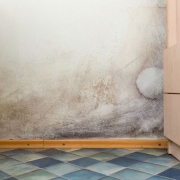Trained Dogs Proving Successful Mold Detection
Milford, CN – Mardi, a dog rescued from New Orleans in the wake of Hurricane Katrina, may not appear to be en expert in detecting mold. But the little Beagle “nose” better. “Because of a dog’s excellent sense of smell, they can pinpoint where mold is located in a building,” said Carl Massicott, the co-owner of a local environmental inspection company. “A trained mold professional is usually about 35 percent accurate, while a dog is more than 97 percent accurate.”
In America, dogs have been used for years by local, state and federal law enforcement agencies and the military to detect bombs and drugs, among other things. In fact, a 1991 Congressional report noted that: “…the dog and handler team remains the most widely used, accurate, durable and flexible system available for detecting illegal drugs and explosives (Technology Against Terrorism, 1991).”
Each year, the Department of Defense, federal, state and local law enforcement agencies spend considerable resources to breed, raise, purchase, train and maintain working dogs. On September 11, 2001, dogs were among the first to be called to duty to search for survivors. Since then, the use of dogs to search our airports and seaports for explosives has grown exponentially and dogs continue to play a critical role in protecting the United States from terrorism and other threats.
Research Behind the Mold-Detecting Dog
Several years ago, the insurance industry posed a question to Bill Whitstine, owner of Florida Canine Academy: “If dogs can sniff out bombs, drugs, people and arson,
then why not mold?”
In response to this question, Whitstine immediately put together a panel of experts to include: Chief forensic chemist Niles Bashaw of Innovative Applied Science Laboratory, in Tampa, Florida; Microbiologist and Industrial Hygienist Michael Williamson of Apollo Environmental Inc. in Gibsonton, Florida; and for veterinarian and research support, Dr. Larry Myers of Auburn University, in Auburn, Georgia. After more than two years of study, this panel of experts concluded that dogs could, in fact, be trained to sniff out specific microbial volatile organic compounds associated with over 18 specific species of the most common ‘toxic’ molds.
Later, armed with the support of the experts, Whitstine began training the first dogs with a few mold odors. Once it was clear that dogs could find the hidden mold in various building structures, Whitstine began to fine-tune the dogs’ detection abilities by adding additional odors.
Finding hidden mold is not as hard as finding arson, bombs or drugs. For example, arson-detection dogs must alert to more than 30 different types of accelerants and must be able to do so after an arsonist has poured gasoline in a buildings, the building has burned to the ground, the firefighters have put thousands of gallons of water on the fire, and all of the burned items are masking the odor of the trace amounts of accelerant left. The dog must then sniff through the ashes and accurately pinpoint the remaining parts per trillion of gasoline left. Similarly, drug dealers routinely try to hide their drugs by masking the odor with items such as coffee or fabric softener, but still the dogs find it. By way of contrast, mold is not hiding from us; however, mold is frequently not visible to the human eye.
In cases of intermittent damp walls, how does one pinpoint the exact problem? Thermal imaging and other scientific equipment has only proven to be half-correct in targeting the exact problem. Dogs have been able to find the problem almost every time in less than a fraction of the time than the standard ‘professional’, and I many cases where the professional was unable to even find the problem.
Massicott began using Mardi and two other dogs to detect mold about three months ago. The dogs, all rescued from humane societies, are among the first in the state being used to detect mold. The dogs received more than 1,000 hours of training from the Florida Canine Academy.
Training to e a Mold-Detecting Dog
At the Florida Canine Academy, mold-detecting dogs are trained to discriminate scents of various types of microbial colonies in a variety of structures, including attics and crawl spaces. The method of indication is a passive method (sit). If the dog finds mold, the dog will alert the handler to the location. The mold dogs receive 800 to 1100 hours of training and are proficient in their duties before the handler arrives at the Academy. The mold dog and handler are then paired and trained together for a minimum of 40 hours.
Quarterly testing and annual recertification are required. At the end of the course, the Certified Master Trainer verifies that each canine team is capable of discriminating scents of the mold and issues certification.
The extremely qualified mold inspectors use dogs as only one tool to detect moisture and mold problems. The dogs are extremely well-cared for and generally only brought into moldy buildings for a short period of time to detect initial problems, saving precious time and money for the customer.
Bill Whitstine, trainer and owner of the academy, said, “We start out by just driving the dog around and getting it used to a vehicle. We also start by getting them used to people and buildings so they are curious, but not scared. Then we start with odor repetition.”
Whitstine said he spent about three years researching and developing the training program for mold dogs. He has trained about 100 dogs, some of which are in other countries including Finland, Mexico and Japan.
The mold-detecting dogs’ training includes minor obedience, odor identification, search patterns, scent discrimination, and various types of building search areas, socialization. The handlers’ training includes canine handling, search patterns, working in different types of buildings and structures, proper care for the dog, canine first aid, canine CPR, sampling and minor obedience techniques as well.
The Mold Dog Represents the Newest Technology and Latest Trend in the Inspection Industry
For consumers, this is great news – quicker and more accurate remediation can leads to lower costs if used effectively as one tool in the quest for thorough inspections. Be aware of companies, however, who only use mold dogs as a source for inspections. It takes a great deal of education and knowledge in finding qualified resources, hence, Mold Help has begun a comprehensive evaluation program where ethical and effective resources can be listed at no cost for either party for the year term they been approved and are being supervised for cost effectiveness, efficacy, and reliable resources.
Seth Norman, director of the National Association of Mold Professionals, said dogs are becoming an increasingly popular tool in the industry. He added that there are about 100 dogs in the country that are trained to detect mold. “They can find mold when normal detection methods just don’t work,” he said. “Those who have used dogs to detect mold can’t say enough good things about them.”
Norman added that public awareness about mold in buildings such as homes and schools has increased in recent years. A recent study suggested that one and three homes in the country have a mold problem, he said. “People are beginning to realize that mold can cause a lot of severe health and structural problems,” he said. “Many states are now requiring mold disclosures for real estate transactions. Mold detection is becoming a standard practice in many areas.”
Brian Toal, an epidemiologist with the state Department of Public Health, claims that mold is only a respiratory irritant that can cause symptoms similar to hay fever. Currently, there are thousands of clinical studies that have concurred that mold exposure can cause permanent neurological, pathological, psychological, and immunological problems. The cover-ups continue, while science is paving the road to the truth; mold exposure can be very dangerous, depending on the species of mold one has been exposed to.
Ann Berman, president of the Milford Environmental Concerns Coalition, said mold is becoming the new asbestos. Berman recently used the services of a company that uses mold dogs to detect moisture and mold problems in order to uncover a growing mold problem in her own home. “I recently developed a case of the sniffles and suspected that I might have a mold problem,” she said, adding that the company located two areas in her home affected by mold. “If dogs can detect bombs and drugs, then why not mold?”
Massicott said he recently received Jada, a Labrador mixed breed that’s one of the first dogs trained in the country to detect another growing pest problem, bedbugs.
“Many people believe that bedbugs are a myth, but they’ve become more prevalent over the last decade,” he said, adding that bedbugs can go for nearly a year between meals of blood. “An exterminator can search a typical hotel room for bedbugs in about 30 minutes, while a dog can search the room in less than a minute.”
Officials with the Connecticut Agricultural Experiment Station in New Haven said bedbugs are becoming a major concern, not only in the state but throughout the nation. As a result, purchasing of used mattresses and furniture have become a growing health concern. “Fortunately, they don’t transmit any diseases but they can cause mild to severe allergic reactions for people bitten by them,” claims Ken Welch, an entomologist with the station. “Somebody who is allergic, like myself, can get large, itchy welts on their bodies from a bite.” But if an insect can suck blood from a human, what has history shown us in the past? How many times has the public been fed the word, ?allergic?? Mold Help has uncovered such claims before and intends to stay on top of the growing concerns of environmental illness and its pathology.
He added that human-biting bedbugs, which have a reddish-brown coloring as an adult, tend to hide close to their food source near paper, fabric or wood surfaces. “They tend to feed at night when their food source is stationary,” Welch said. “The toughest part about getting rid of them is knowing where they’re hiding.”
Mold Help, in an effort to assist in the prevention of such illnesses from parasites such as mold and other pathological predators, is conducting scientific research to assist our consumers. Mold Help conducts all current research through ethical resources, such as Dr. George Carroll from the University of Oregon.
“We are trying to create awareness with the public in a non-biased presence so we can enable them to make educated and cost-effective choices in the growing trend of environmental health,” states Susan Lillard-Roberts, National Spokeswoman for the Mold Help Organization. “Our panel of experts is dedicated to enhancing the quality of life and creating awareness for generations to come.” Mold Help is the leader in evaluating cost effective, consumer conscience resources in enabling the public in making correct and effective choices for their particular needs. This organization is dedicated to protecting people who are uneducated in the myths of environmental disease to make cost-effective decisions that are in their best benefit with emphasis on proven science and resolution based upon laboratory and well-researched data.








